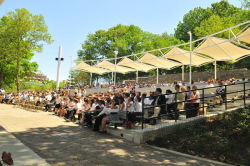Historic Harlem Parks
Hamilton Grange
What was here before?
Before the arrival of Europeans and enslaved people, the Lenape lived on the land that was named Manahatta. About 15,000 individuals from the Algonquian or Delaware tribes lived across what is now New York City.
How did this site become a historic house?
Construction of the house began in 1801 and was designed by John McComb Jr. with input by Alexander Hamilton. This two-story Federal-style country estate, originally located on what is now 143rd Street between Covenant and Amsterdam Avenues, was named The Grange after Hamilton’s paternal grandfather’s estate in Scotland.
In 1899, the house was moved 500 feet to accommodate the Manhattan street grid plan but remained on the original 32-acre estate. A new foundation and basement were built to support the house in the new location, and it served as a chapel and later a rectory for St. Luke’s Church.
It was designated a National Historic Landmark in 1960 and a New York City Landmark in 1967. In 1976 Congress passed legislation establishing Hamilton Grange as a national memorial.
As the area around the house became more developed, the house was moved again in 2008 to its current location for more ample space. In 2011, the restored property opened to the public as the Hamilton Grange National Memorial, operated by the National Park Service. The former site of the home is currently a garden with a statue of Alexander Hamilton.
Who is this historic house named for?
Alexander Hamilton (1757-1804) was a statesman, lawyer, solider, and founding father of the United States, and a resident of the neighborhood that has become known as Hamilton Heights.
Born in the British West Indies, Hamilton moved to New York in 1772 for his formal education, attending King’s College (now Columbia University). While still a teenager, he volunteered for service in the Revolutionary War in a New York artillery company, where he rose to the rank of captain. From 1777-1781, Hamilton served as an aide-de-camp to General George Washington at the rank of Lieutenant Colonel.
After the war, Hamilton married Elizabeth Schuyler in 1780, connecting him to one of New York’s most powerful families. Hamilton was admitted to the bar in 1782 and began to practice law in New York. He also served as a delegate in the Continental Congress and served in the New York State Legislature, playing an important role in the ratification of the United States Constitution in New York. A supporter of a strong federal government, Hamilton was appointed the first Secretary of the Treasury by President Washington in 1789 when the new government was set up in New York City. While holding this position, Hamilton laid out his legacy in fiscal policy, giving the new nation both a circulating medium and financial machinery. His concentration on business aided the growth and development of New York City as a financial center. He also provided public credit and developed plans for a congressional charter for the first Bank of the United States.
Hamilton retired from his cabinet position in 1795 but stayed active in public life. He resumed his law career and remained an important political advisor, starting the New York Evening Post in 1801 to present his opinions. In 1800, he began construction of this Harlem country home and it was completed in 1802, two years before his death in 1804, when Hamilton was fatally wounded in a duel with Aaron Burr.
Check out your park's Vital Signs
Clean & Safe
Green & Resilient
Empowered & Engaged Users
Share your feedback or learn more about how this park is part of a
Vital Park System

